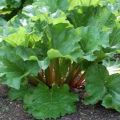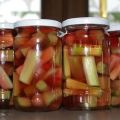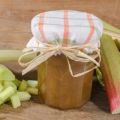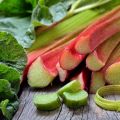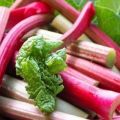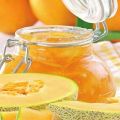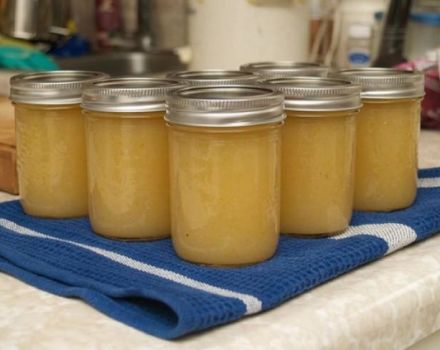7 recipes for making rhubarb jam with orange and lemon
For those who have never tried rhubarb jam with the addition of oranges, do not know about the beneficial properties of this perennial herb, this information will certainly be interesting. Today, rhubarb has practically been eradicated from vegetable gardens and summer cottages. But in vain - it contains many useful substances, its composition is similar to the composition of sorrel, which is more popular among summer residents. We will tell you how to use this valuable product of our gardens, how to cook delicious, original jam from it for the winter.
Features of making rhubarb jam
The stems selected for conservation must be cleaned of hard veins and superficial skin - all this is hard and damages the taste of the product. A few more tips before cooking:
- if you can't cook the jam right away, you can keep the stems fresh. Place them in a plastic bag before cooking and refrigerate. In refrigerators of the No Frost system, rhubarb remains worse than in devices with conventional dynamic cooling;
- according to the cooking technology, such a workpiece should be cooked in two steps, with an interval between cooking in half a day. This is done so that the rhubarb is saturated with the sweet syrup and remains transparent;
- the acid contained in the petioles preserves the workpiece well, therefore the product will stand for a long time without any sterilization.
Useful properties of the product
The young petioles of the plant contain an optimal set of substances useful to the human body. These are malic and ascorbic acids, vitamins and various trace elements. In addition, there is a lot of pectin, which makes it possible to prepare excellent jelly, as well as compotes, jams, jam, etc.
Rules for the selection and preparation of ingredients
Many people consider rhubarb to be a vegetable, but in fact it is a perennial herb, in which the aboveground part is considered edible - leaves and stems. The root is not eaten, it contains poisonous substances. However, as a rule, only petioles, that is, stems, are used for food. The leaves are rough and look like burdocks.
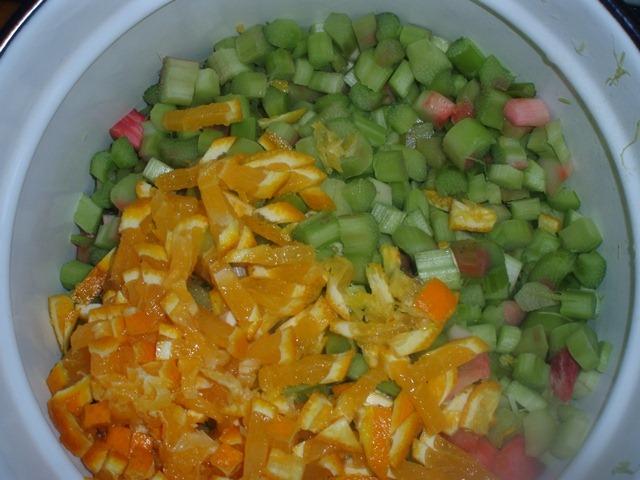
The peculiarity of the plant is that its collection is very short - you need to cut the stems in May, in some latitudes until mid-June. Further harvesting is unsafe, because later the leaves and petioles accumulate a lot of oxalic acid. Petioles become tasteless and unhealthy, especially for people suffering from gastrointestinal diseases.
Oxalates, which are present in oxalic acid, in large volumes can lead to intoxication.
Therefore, we harvest quickly, choosing stems that are thick, fleshy, well-colored with a reddish color. Jam from such raw materials will be both tasty and beautifully pinkish.
How to prepare containers for the start of the process?
When preparing containers for jam, remember that the plant is sour, and therefore it is better to cook it in a pouring pan or in a basin or in a stainless steel dish. Copper pots, like tin pans, will not work - they quickly undergo oxidation.
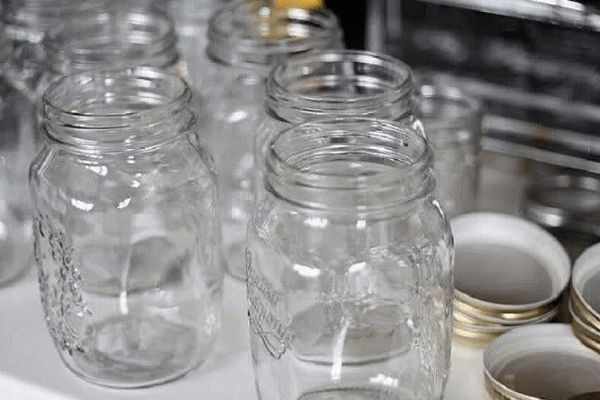
The jars and lids are washed and sterilized as usual. It is very important that they are not only clean, but also dry before placing the jam, otherwise the workpiece may sour.
The best cooking recipes
Many have underestimated the jam from this herb so far. Including because they do not know how to cook it. Spring rhubarb is the first to be harvested, even before strawberries. And if you refine it with fruits, for example, oranges, then we get a fragrant, slightly sour jam with a delicate and refined taste. Several cooking recipes.
Rhubarb jam with orange in a saucepan
The jam is usually cooked in a bowl, but rhubarb requires pre-blanching, so it can be cooked in the same saucepan that you blanched in.
Products:
- 1 kg of petioles;
- 1600 g granulated sugar;
- 2 glasses of water;
- 3 large oranges.
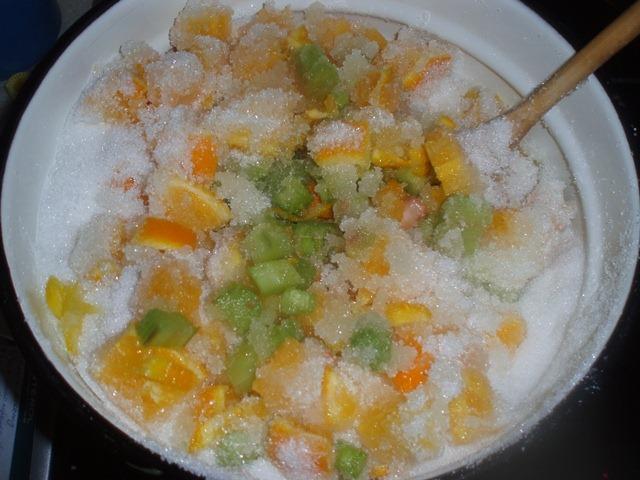
Cooking like this:
- Place rhubarb stalks cut into 1 cm long into a saucepan of boiling water, blanch for a minute.
- Drain the water - it contains oxalic acid. Pour sugar into a saucepan, pour 2 cups of water and prepare syrup.
- Put the petioles in boiling syrup and bring to a boil.
- Leave for 12 hours to soak the rhubarb syrup.
- Cut the oranges into circles, divide each circle into quarters. Fold over rhubarb and let it boil. After boiling, boil well over very low heat to soften the fruit. Stir gently from time to time, avoiding burning. Do not peel the oranges, it gives the jam a flavor and a specific bitterness.
- Put the finished jam in jars and roll up.
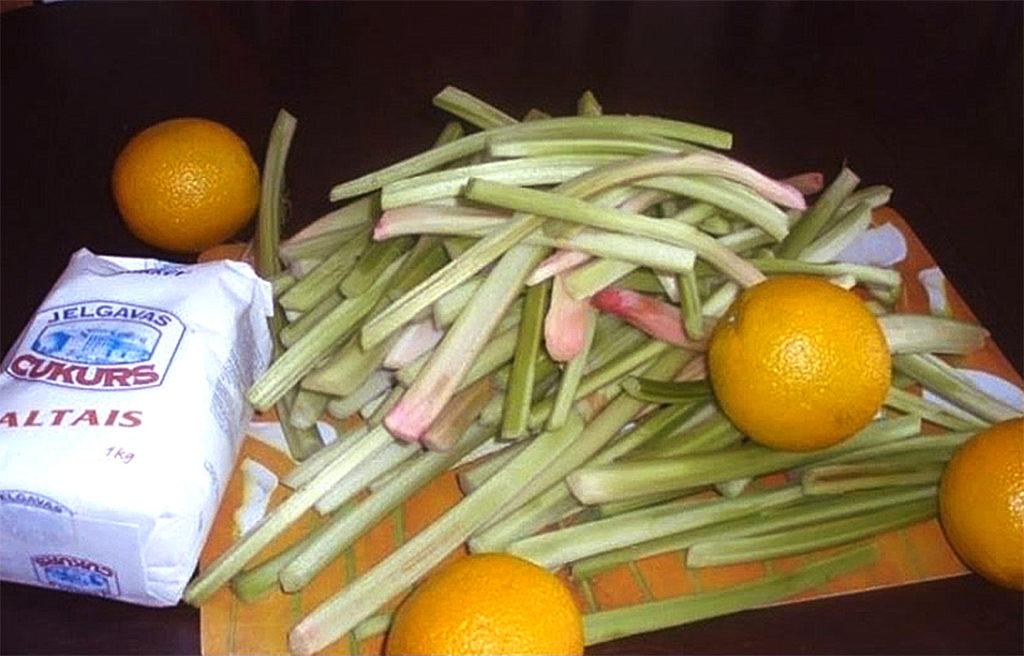
Quick way
Dessert for the winter can be prepared without double cooking. It is done like this.
We take:
- 1 kg of rhubarb;
- 1.5 kg of sugar;
- 3 oranges.
Working process:
- Put peeled and cut stalks into a deep basin, cover with sugar. Rhubarb is juicy enough to give juice after three hours.
- Put the basin on a low heat and wait for the jam to boil.
- In the meantime, remove the zest from the orange (you can use the whole peel, but only the zest is more aromatic). Cut it into thin long strips. Put in a basin.
- Peel the orange veins and chop the pulp coarsely.
- Put in jam and let it boil.
- Hot to put in jars, roll up.

Multicooker recipe
The same recipe works well in a slow cooker. The difference in proportions - the bowl holds less food, so you will have to shorten the bookmark:
- a pound of medium-sized cut petioles;
- 800 g granulated sugar;
- a couple of oranges.
We cook in the same way as in the previously given recipe: add sugar, heat after three hours, add orange zest and pulp, put the bowl in a slow cooker with stewing mode and cook for an hour. We pack in containers and tighten the lids.
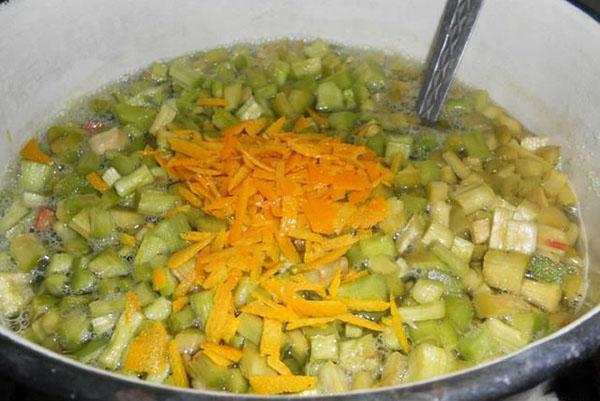
With the addition of banana
Banana jam has an even richer flavor and less sugar:
- 2 kg of rhubarb;
- 4 oranges and 4 bananas;
- 600 g of sugar.
The preparation is quite simple - leave chopped rhubarb sprinkled with sugar in a saucepan overnight. In the morning, add sliced banana circles and orange semicircles to the mass (do not peel off the skin!). After stirring, put to heat and, bringing to a boil, boil over low heat for five minutes. After that, put in jars and roll up.
With ginger
Rhubarb and orange jam can be an excellent warming agent if you add ginger to it. A spicy, aromatic spice will add additional notes to taste and will help with many diseases.

Cooking:
- 1 kg of rhubarb and sugar;
- 1 orange;
- to taste of ginger root.
Put chopped rhubarb, sugar in a basin, leave for 12 hours. As soon as the juice appears, set to cook. In the meantime, it boils, grind ginger and orange in a meat grinder and put this mass in rhubarb.
The jam is cooked over low heat and stirring for 40 minutes, after which it is ready. We pack.
With lemon
For 2 kg of rhubarb:
- 1 kg of granulated sugar;
- 1 glass of water;
- one lemon and one orange.
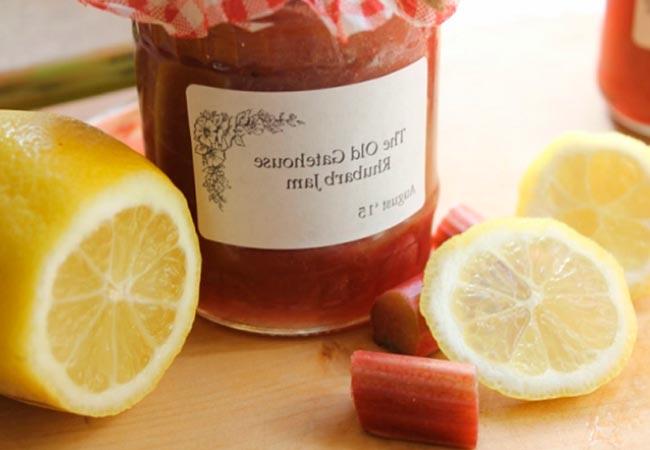
The taste and aroma of this jam is rich, bright, the preparation for pies is perfect. It is prepared like this:
- Grind all fruits and rhubarb to the same size.
- Combine rhubarb with sugar and water, cook. You can cook without water, but in this case the rhubarb is sprinkled with sugar and stands until the juice is released. The jam without water will be thicker.
- As it boils, add citrus fruits, bring to a boil and remove from heat.
- Let it cool and bring it to a boil again. We do this three times. After that, the jam is ready.
With apples
Jam with apples:
- 2 kg of rhubarb;
- 400 ml of water;
- 2 oranges;
- 0.8 kg of apples;
- 3 kg of sugar.
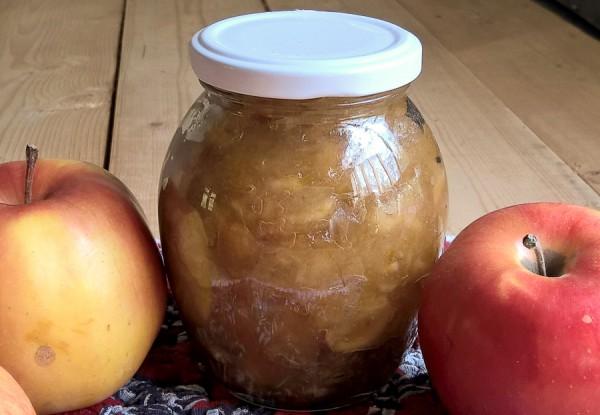
Do not be embarrassed by such an amount of sugar - rhubarb is sour, apples during cooking are also sour than raw ones, so it will be fine. Thanks to apples and their pectin content, the jam will be thick even with water.
The dessert is prepared like this:
- diced rhubarb and apples are transferred to a saucepan and boiled in water for 15-20 minutes;
- pour sugar into the pan, put orange slices with skin and boil again for 20 minutes;
- laid out in jars, closed with lids.
How and how long is the finished product stored?
Rhubarb jam does not require special storage conditions, as it is quite sour and contains a lot of sugar. Nevertheless, if you cook a five-minute period, then it is better to store such a dessert in the refrigerator. And what has been cooked for a long time is stored in room conditions, in a dark and cool place.


